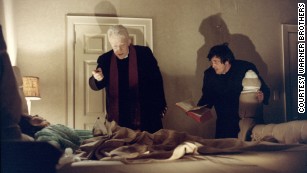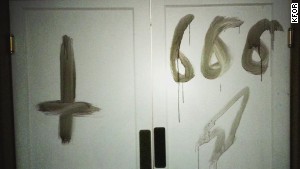Doctor who Helps Exorcists: “Demonic possession is real” Sees 90 pound woman throw 200 pound Deacon Across Room

Follow Mystic Post on Facebook!
I am calling you to be my apostles.”
(CNN)A small group of nuns and priests met the woman in the chapel of a house one June evening. Though it was warm outside, a palpable chill settled over the room.
As the priests began to pray, the woman slipped into a trance — and then snapped to life. She spoke in multiple voices: One was deep, guttural and masculine; another was high-pitched; a third spouted only Latin. When someone secretly sprinkled ordinary water on her, she didn’t react. But when holy water was used, she screamed in pain.
“Leave her alone, you f***ing priests,” the guttural voice shouted. “Stop, you whores. … You’ll be sorry.”
You’ve probably seen this before: a soul corrupted by Satan, a priest waving a crucifix at a snarling woman. Movies and books have mimicked exorcisms so often, they’ve become clichés.
But this was an actual exorcism — and included a character not normally seen in the traditional drive-out-the-devil script.
Dr. Richard Gallagher is an Ivy League-educated, board-certified psychiatrist who teaches at Columbia University and New York Medical College. He was part of the team that tried to help the woman.
Fighting Satan’s minions wasn’t part of Gallagher’s career plan while he was studying medicine at Yale. He knew about biblical accounts of demonic possession but thought they were an ancient culture’s attempt to grapple with mental disorders like epilepsy. He proudly calls himself a “man of science.”
Yet today, Gallagher has become something else: the go-to guy for a sprawling network of exorcists in the United States. He says demonic possession is real. He’s seen the evidence: victims suddenly speaking perfect Latin; sacred objects flying off shelves; people displaying “hidden knowledge” or secrets about people that they could not have possibly have known.
“There was one woman who was like 90 pounds soaking wet. She threw a Lutheran deacon who was about 200 pounds across the room,” he says. “That’s not psychiatry. That’s beyond psychiatry.”
Gallagher calls himself a “consultant” on demonic possessions. For the past 25 years, he has helped clergy distinguish between mental illness and what he calls “the real thing.” He estimates that he’s seen more cases of possession than any other physician in the world.
“Whenever I need help, I call on him,” says the Rev. Gary Thomas, one of the most famous exorcists in the United States. The movie “The Rite” was based on Thomas’ work.
“He’s so respected in the field,” Thomas says. “He’s not like most therapists, who are either atheists or agnostics.”
Gallagher is a big man — 6-foot-5 — who once played semipro basketball in Europe. He has a gruff, no-nonsense demeanor. When he talks about possession, it sounds as if he’s describing the growth of algae; his tone is dry, clinical, matter-of-fact.
Possession, he says, is rare — but real.
“I spend more time convincing people that they’re not possessed than they are,” he wrote in an essay for The Washington Post.
Some critics, though, say Gallagher has become possessed by his own delusions. They say all he’s witnessed are cheap parlor tricks by people who might need therapy but certainly not exorcism. And, they argue, there’s no empirical evidence that proves possession is real.
Still, one of the biggest mysteries about Gallagher’s work isn’t what he’s seen. It’s how he’s evolved.
How does a “man of science” get pulled into the world of demonic possession?
His short answer: He met a queen of Satan.
A ‘creepy’ encounter with evil
She was a middle-age woman who wore flowing dark clothes and black eye shadow. She could be charming and engaging. She was also part of a satanic cult.
She called herself the queen of the cult, but Gallagher would refer to her as “Julia,” the pseudonym he gave her.
The woman had approached her local priest, convinced she was being attacked by a demon. The priest referred her to an exorcist, who reached out to Gallagher for a mental health evaluation.
Why, though, would a devil worshipper want to be free of the devil?
“She was conflicted,” Gallagher says. “There was a part of her that wanted to be relieved of the possession.”
She ended up relieving Gallagher of his doubts. It was one of the first cases he took, and it changed him. Gallagher helped assemble an exorcism team that met Julia in the chapel of a house.
Objects would fly off shelves around her. She somehow knew personal details about Gallagher’s life: how his mother had died of ovarian cancer; the fact that two cats in his house went berserk fighting each other the night before one of her sessions.
Julia found a way to reach him even when she wasn’t with him, he says.
He was talking on the phone with Julia’s priest one night, he says, when both men heard one of the demonic voices that came from Julia during her trances — even though she was nowhere near a phone and thousands of miles away.
He says he was never afraid.
“It’s creepy,” he says. “But I believe I’m on the winning side.”
How a scientist believes in demons
He also insists that he’s on the side of science.
He says he’s a stickler for the scientific method, that it teaches people to follow the facts wherever they may lead.
Growing up in a large Irish Catholic family in Long Island, he didn’t think much about stories of possession. But when he kept seeing cases like Julia’s as a professional, he says, his views had to evolve.
“I don’t believe in this stuff because I’m Catholic,” he says. “I try to follow the evidence.”
Being Catholic, though, may help.
Gallagher grew up in a home where faith was taken seriously. His younger brother, Mark, says Gallagher was an academic prodigy with a photographic memory who wanted to use his faith to help people.
“We had a sensational childhood,” Mark Gallagher says. “My mother and father were great about always helping neighbors or relatives out.” Their mother was a homemaker, and their father was a lawyer who’d fought in World War II. “My father used to walk us proudly into church. He taught us to give back.”
Gallagher’s two ways of giving back — helping the mentally ill as well as the possessed — may seem at odds. But not necessarily for those in the Catholic Church.
Contemporary Catholicism doesn’t see faith and science as contradictory. Its leaders insist that possession, miracles and angels exist. But global warming is real, so is evolution, and miracles must be documented with scientific rigor.
Some stories blur the lines between science, spirituality and the supernatural. These stories are from “The Other Side.”
Where do coincidences come from?
Synchronicity is familiar to many people, yet few understand how it works. Are our lives are shaped by unseen hands? Or are we victims of psychological narcissm?
Beyond Goodbye
Some people not only share their life but their moment of death with loved ones. Are these “shared-death experiences” real or a mirage?
Why Bigfoot is getting nervous
Monster stories have been around for millennia. Now hunters are hot on the trail, armed with cameras, drones and night-vision goggles. Can they catch one?
Ghost hunters haunted by competition
We’ve heard of ghosts that harass the living. Now people are starting to harass the ghosts. Across America, teams are creeping through people’s homes, trying to get rid of their paranormal pests.
Heaven popular, except with the church
Popular culture is filled with accounts from people who claim to have near-death experiences. So why doesn’t the church talk about heaven anymore?
Bidding farewell from beyond the grave?
Although visits by the spirits of the recently departed can be chilling, they are also comforting, say those who’ve seen these “crisis apparitions.” Can bonds between loved ones defy death?






